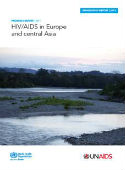HIV/AIDS in Europe and central Asia. UNAIDS/WHO report 2011

Download
In 2006, a quarter of a century after the first case of HIV was identified, the United Nations Member States met to assess the international response to the epidemic, as articulated in their 2001 Declaration of Commitment on HIV/AIDS. At this meeting, world leaders pledged to provide universal access to comprehensive HIV prevention, treatment, care and support. Since then, many countries in Europe and central Asia have made achieving universal access a public health priority.
In June 2011 at the United Nations High Level Meeting on AIDS, Member States unanimously adopted a new declaration (A/RES/65/277), Political Declaration on HIV/AIDS: Intensifying our Efforts to Eliminate HIV/AIDS, setting bold new targets and calling on Member States to redouble efforts to achieve by 2015 universal access to HIV prevention, treatment, care and support, with a view to attaining Millennium Development Goal 6. The declaration is also commendable for recognizing key populations at higher risk of HIV infection and transmission, including men who have sex with men, people who inject drugs, and sex workers.
Although Europe and central Asia has made universal access a high priority, the region is one of only two in which the incidence of HIV infection continues to rise. An estimated 2.3 million people were living with HIV in Europe and central Asia in 2010, more than twice the 2001 estimate. The rise has primarily occurred in eastern parts of the region, where prevalence of HIV infection among adults has increased to an estimated 0.9% in 2010, three times the 2001 figure. The estimated prevalence in the west and centre of the region has remained stable at 0.2%. HIV prevalence of 1% or more has been reported in three countries in the region (Estonia, the Russian Federation and Ukraine). Despite expanded provision of antiretroviral therapy, mortality continues to increase.



